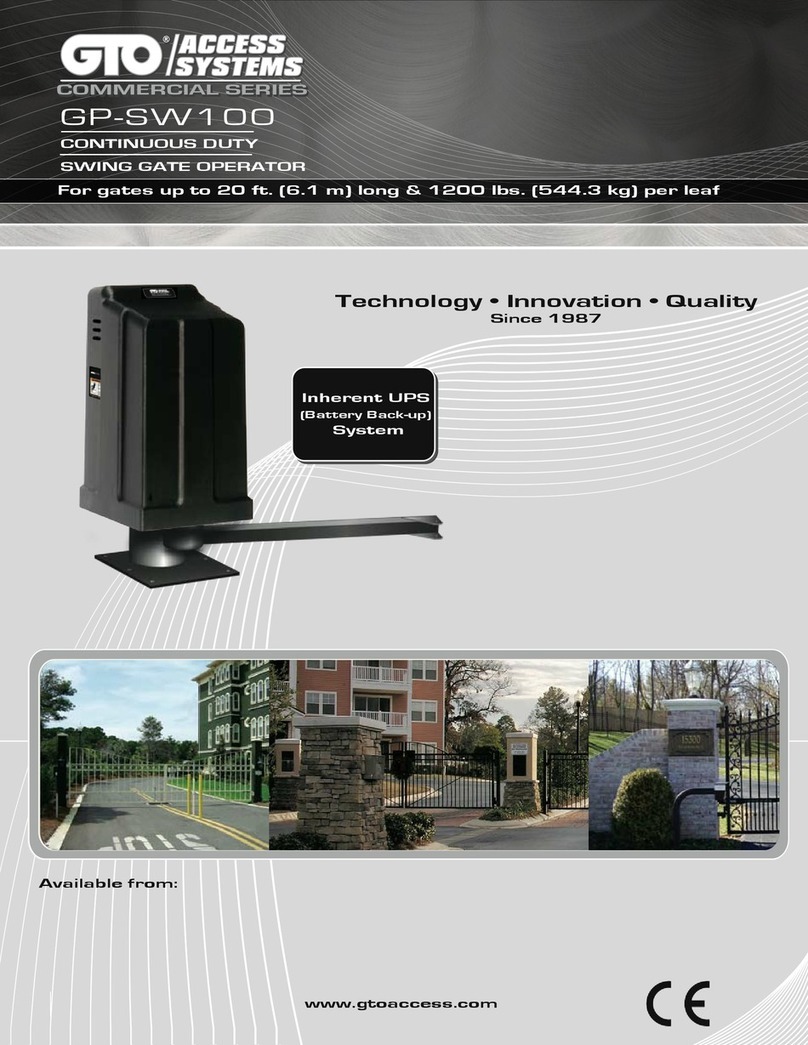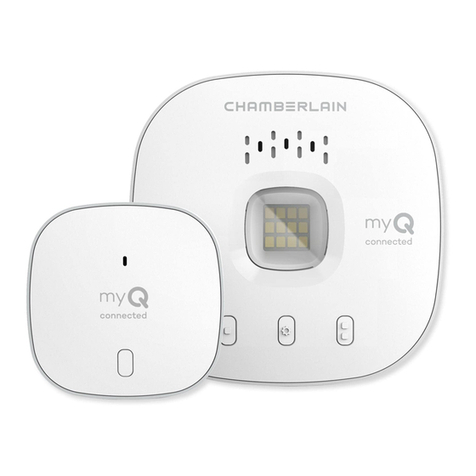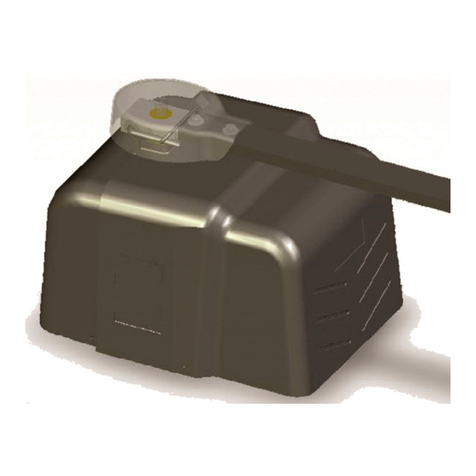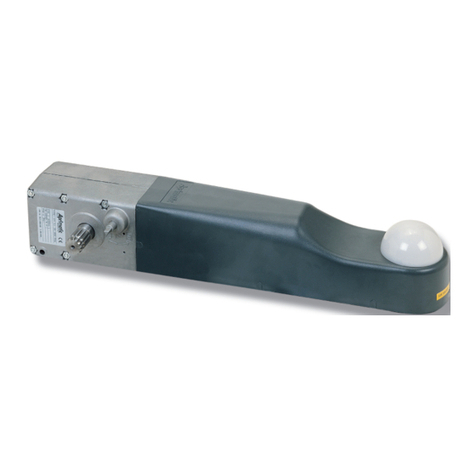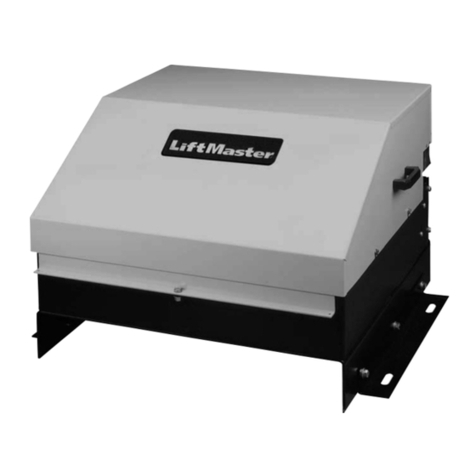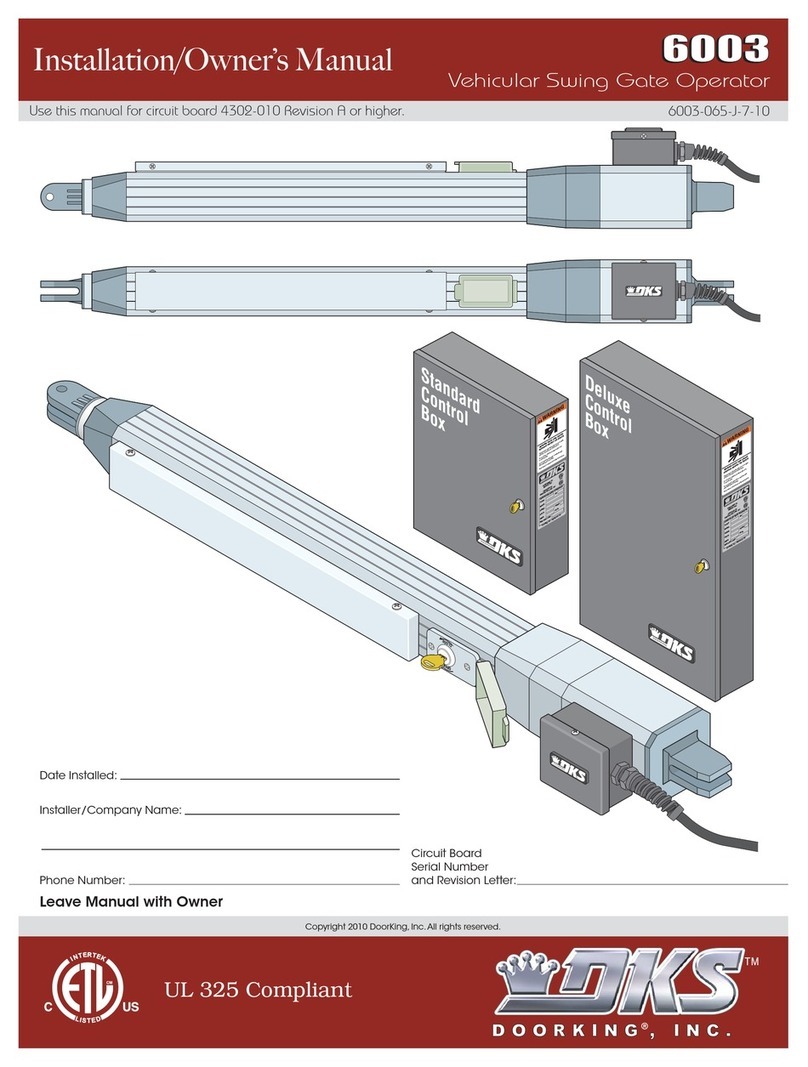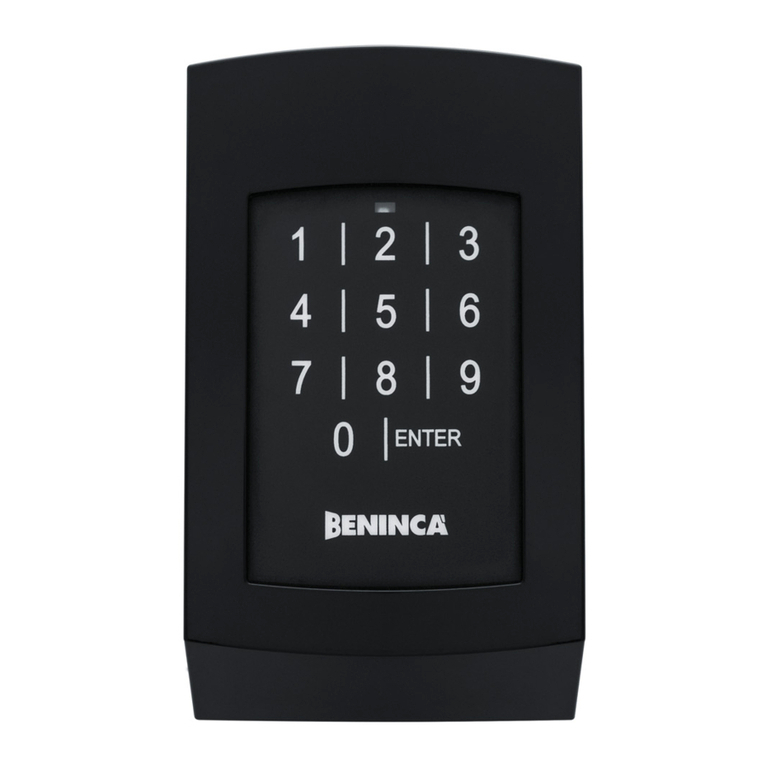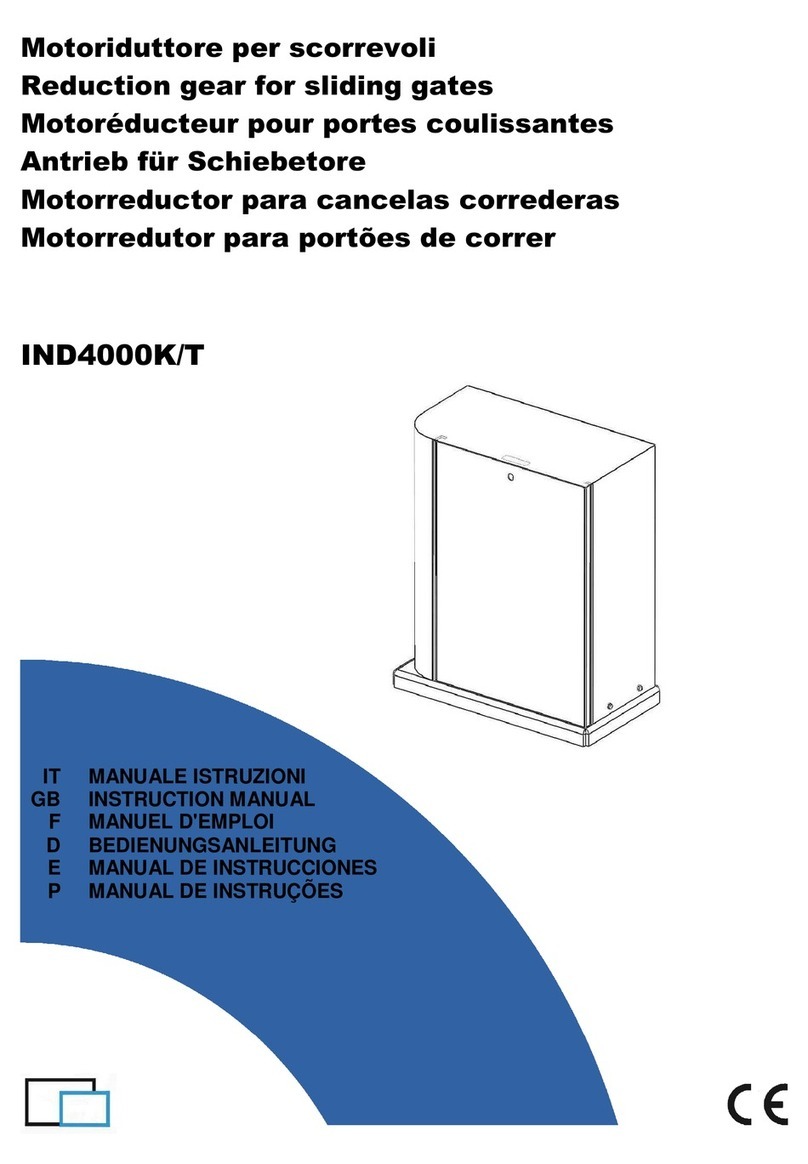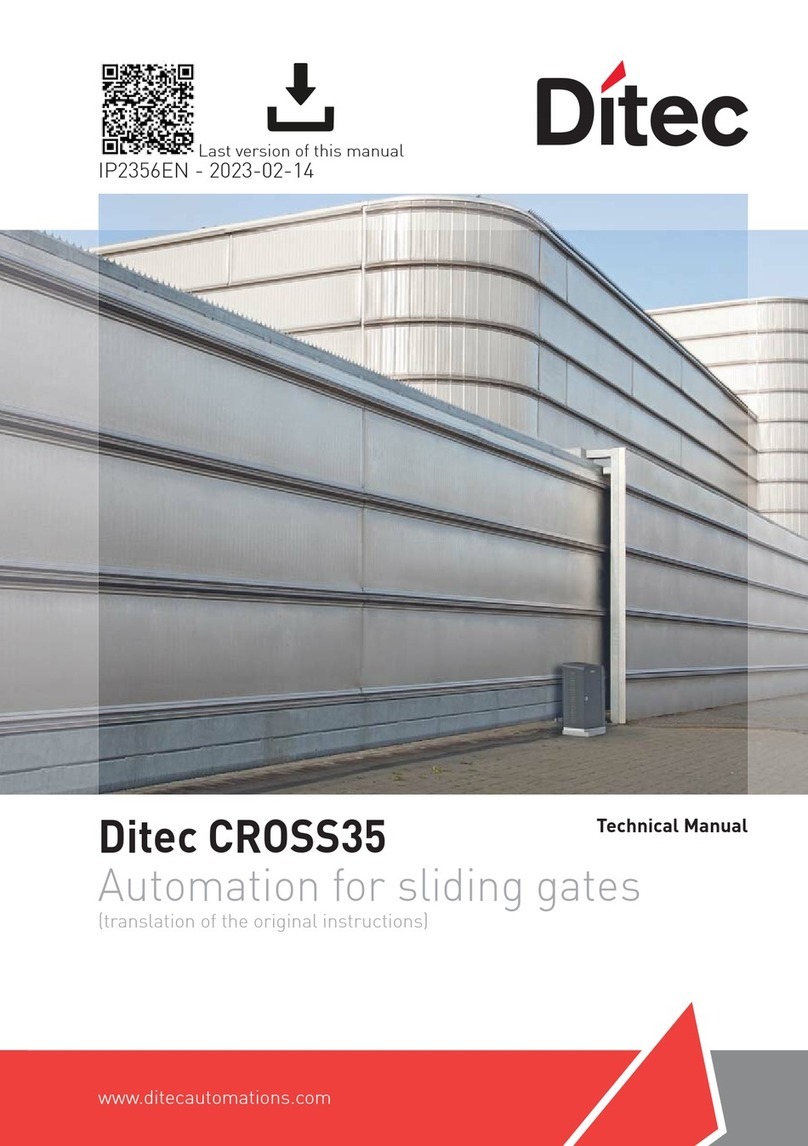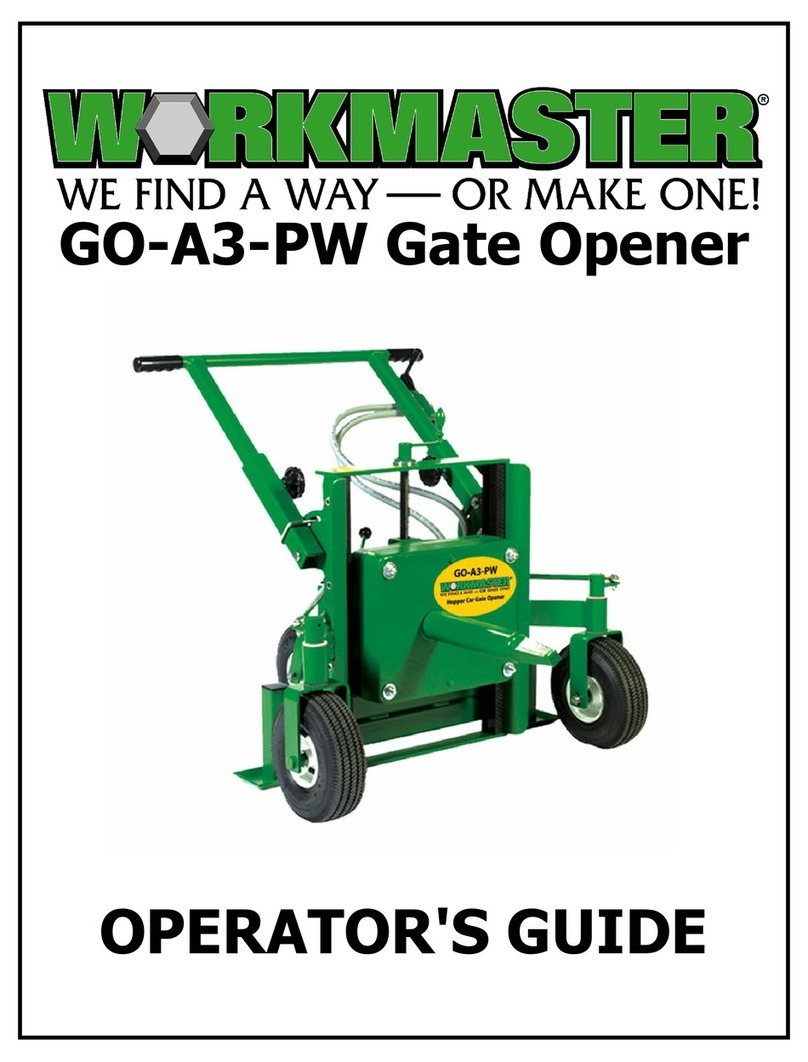Devanco BCSI User manual

SLIDING GATE OPERATOR
MODEL
BCSI
TECHNICAL MANUAL
INSTALLATION AND MAINTENANCE
BCSI
Gate system with BCSI sliding gate operator
For more information, please visit www.devancocanada.com
or call toll free at 855-931-3334

2/27
!
IMPORTANT SAFETY INSTRUCTIONS
WARNING – TO REDUCE THE RISK OF
SEVERE INJURY OR DEATH:
All technicians having to install, maintenance and repair, must read these safety
instructions about sliding gate-system1with BCSI operator.
Any intervention on the gate-system should only be done by qualified technicians
having proper knowledge for that kind of work and appropriate equipment and tools
to work safely.
Any negligence during an intervention could cause severe injury or death. As soon
as you open the cabinet, cut power down by switching the disconnecting switch
(red button) to “OFF” - see section “2.5 – Shutting down the equipment“.
Do not proceed with installation of this gate operator if:
1) The model class of this gate isn’t appropriate for your installation, following
model classes defined by UL 325.
2) All exposed pinch points are not eliminated or guarded.
3) Guarding is supplied for exposed rollers.
The gate operator is the main component of your system. It mainly consists of an
electrical motor, a reducer and various mechanical parts, enabling the gate to open
and close. There is also, inside the cabinet, a control panel interfaced with various
control and security features.
The gate is the moving part of your installation.
When moving, the gate represents a high risk of injuries if not correctly used.
All sliding gates must be equipped, according to their use, with appropriate safety
features for safe operations. You must communicate with us to know the rules to
follow in case of special installation.
This gate is intended only for vehicles. Pedestrians must be supplied with a
separate access opening. The pedestrian access opening shall be designed to
promote pedestrian usage. Locate the gate such that persons will not come in
contact with the vehicular gate during the entire path of travel of the vehicular gate.
1By “gate-system”, we represent the whole installation including the gate, the operator, the control panel, the
access system and any other auxiliary equipment related to site secure.

PIVIN & DRAPEAU inc.
3/27
The sliding gate can cause severe injuries or even death.
It is strictly forbidden to allow pedestrians to walk through the gate.
The gate must be installed in a location so that enough clearance is supplied
between the gate and adjacent structures when opening and closing to reduce the
risk of entrapment.
The gate must be properly installed and work freely in both directions prior to the
installation of the gate operator. Do not over-tighten the operator clutch (by
screwing bolts) to compensate for a damaged gate.
Controls intended for user activation must be located at least six feet (6’) away
from any moving part of the gate and where the user is prevented from reaching
over, under, around or through the gate to operate the controls. Outdoor or easily
accessible controls shall have a security feature to prevent unauthorized use.
The Stop and/or Reset button must be located in the line-of-sight of the gate.
Activation of the reset control shall not cause the operator to start.
A minimum of two (2) WARNING SIGNS shall be installed, one on each side of the
gate where easily visible.
One or more contact sensors shall be located where the risk of entrapment or
obstruction exists.
Warning signals showing risk of injuries that can be cause by a rising gate must be
installed.
Never let children operate gate controls or play close to the gate, even under
adult supervision.
If you have any doubt about your installation or for any information, contact us
directly or contact your authorized dealer of gates from
PIVIN & DRAPEAU Inc.
Intervention site
Any technician having to work on a gate-system must establish a safety perimeter
around the electrical rising gate with yellow or red safety ribbon. Orange cones can
also be use to establish a safe work area.
Plan a way to divert traffic while working on the gate-system. If that’s impossible,
be sure to put proper signalisation for drivers traveling near the gate area.

PIVIN & DRAPEAU inc.
4/27
Electrical and mechanical security
Lock down the gates power lines while working on the gate-system. Follow all local
rules.
Follow all mechanical safety rules in each gate’s technical manual from Pivin &
Drapeau Inc. Be sure to have this technical manual with you for starting the
equipment.
.

PIVIN & DRAPEAU inc.
5/27
GATE CLASS
Following UL 325 definitions above, the sliding gate operator BCSI is intended for
use in class III and IV.
RESIDENTIAL VEHICULAR GATE OPERATOR – CLASS I – A vehicular gate
operator (or system) intended for use in a home of one-to four single family
dwelling, or a garage or parking area associated therewith.
COMMERCIAL/GENERAL ACCESS VEHICULAR GATE OPERATOR – CLASS II
– A vehicular gate operator (or system) intended for use in a commercial location
or building such as a multi-family housing unit (five or more single family units),
hotel, garages, retail store, or other building servicing the
general public.
INDUSTRIAL/LIMITED ACCESS VEHICULAR GATE OPERATOR – CLASS III – A
vehicular gate operator (or system) intended for use in an industrial location or
building such as a factory or loading dock area or other locations not intended to
service the general public.
RESTRICTED ACCESS VEHICULAR GATE OPERATOR – CLASS IV – A
vehicular gate operator (or system) intended for use in a guarded industrial location
or building such as an airport security area or other restricted access locations not
servicing the general public, in which unauthorized access is prevented via
supervision by security personnel.

PIVIN & DRAPEAU inc.
6/27
TABLE OF CONTENTS
1. INTRODUCTION................................................................................................. 7
2. GENERAL POINTS............................................................................................. 8
2.2 General view of gate operator........................................................................ 9
2.3 General view of moving part of the sliding gate: .......................................... 12
2.5 Shutting down the equipment ...................................................................... 13
2.6 Manual operation of the gate ....................................................................... 14
3. INSTALLATION PROCEDURE ......................................................................... 15
3.1 Gate operator installation............................................................................. 16
3.2 Main chain adjustment................................................................................. 18
3.3 Limit switches adjustments: ......................................................................... 19
3.4 Torque limiter adjustment ............................................................................ 20
3.5 Disengaging mechanism.............................................................................. 21
3.6 Photocell beam wiring.................................................................................. 22
3.7 Safety edges wiring ..................................................................................... 22
3.8 Placards installation..................................................................................... 23
3.9 Electrical wirings .......................................................................................... 23
4. MAINTENANCE MANUAL ................................................................................ 24
5. INSPECTION REPORT..................................................................................... 26

PIVIN & DRAPEAU inc.
7/27
1. INTRODUCTION
The BCSI is a sliding gate operator designed and built entirely by PIVIN & DRAPEAU
Inc. We are thanking you for this judicious choice. BCSI gates are listed by Intertek
ETL following standard UL325 5th Edition, October 8th 2009 and CSA 22.2 No. 247-
92 (R2008).
Warranty on the BCSI gate operator
The BCSI sliding gate operator, including auxiliary equipment, supplied or supplied
and installed by our company is guaranteed for a one year period from the invoicing
date or from the date of the installation should this date differs. This warranty is
offered for usage under normal conditions.
Inspection and maintenance required
A visual inspection of the components must be done periodically to verify the good
functioning and to perform the maintenance required as per the maintenance guide
of the operator, all this to insure the validity of the warranty.
Any neglect of maintenance that will be evident during a breakage or any damage
caused by any accident to the operator will cancel the guarantee.
Are not included in the warranty
•Breakage, vandalism or accidents caused to the operators;
•Problems caused by snow or ice;
•Readjustments to the loop detector;
•Power supply problems to the operators (breakers, fuses, etc.);
•Service calls caused by customer’s auxiliary systems.
BCSI gates are listed by Intertek ETL following standard UL325 5th Edition,
October 8th 2009 and CSA 22.2 No. 247-92 (R2008).

PIVIN & DRAPEAU inc.
8/27
2. GENERAL POINTS
2.1 General view of a gate system (example):
The sliding gate operator, model BCSI, is designed for vehicular access control in
commercial and industrial areas.
Advantages:
•Completely secures the site;
•Short operation cycle (speed of 1 foot/second);
•Heavy duty mechanism;
•Low operating costs and maintenance;
•Customized design of the aluminum fence frame;
•Standard safety edges;
•Manual opening device.
Fig. 2.1
Gate operator
Gate operator support
posts
Moving part of gate (sliding
fence)
Electromagnetic lock
Access system
Civil installations : fence,
concrete bases, etc.

PIVIN & DRAPEAU inc.
9/27
2.2 General view of gate operator
:
Cabinet (Fig. 2.2.1):
The cabinet, built in aluminum 1/8’’ (3,2 mm) thick, has an entirely welded gutter making
the cabinet a weather proof one of NEMA 3R type. The door has a sealing gasket, a
high security handle with door lock and a stainless steel strap hinge. The aluminum
control box is located inside the cabinet and included all necessary electrical
components for operating the gate.
Mechanics (Fig. 2.2.2):
A worm gear reducer, ratio 40:1, with a “C” flange for motor installation, allows a speed
of 12 inches/second when assembled to a standard motor with 1750 rpm. Available on
request, the operator ‘’BCSI-HV’’, equipped with a frequency drive, allows a speed up to
24 inches/second.
A torque limiter of 4½’’ diameter, adjustable up to 2,800 pounds of pressure, is installed
directly on reducer output shaft. The torque limiter is made of a gear of ratio 50:26 with
two friction disks mounted on a ball bearing and tightened by a spring washer and a
nut. This nut allows adjustments of the required force according to the weight of the
gate. The link between the operator and the gate is made of the main shaft, two
secondary shafts and a #50 gauge chain. The shafts have a 1’’ diameter and are all
mounted on ball bearings that can be lubricate at need according to frequency of
operations.
Fig. 2.2.1
Door Disconnecting switch Control panel protection plate
Aluminum cabinet

PIVIN & DRAPEAU inc.
10/27
Fi
g
. 2.2.2
MotorReducer
Torque limiter
Disengaging mechanism lever
Isometrical view
Front view
Cams stopping plate
Limit switches adjustment cams
Chain
Limit switch
Main driving chain
Disengaging mechanism
Disengaging mechanism
lever
Oil window
Filler cap

PIVIN & DRAPEAU inc.
11/27
Control panel:
A programmable logic controller (PLC) analyses the information and controls the
gate operations. When in automatic operating mode, the PLC closes the gate after
a delay ranging from 0 to 60 seconds, delay that can be set by an adjustable timer.
A second timer stops the gate after the maximum opening/closing movement time
is reached.
The opening and closing paths are controlled by quick action limit switches. They
are activated by cams on worm gears mounted on ball bearings.
The BCSI sliding gate operator can be equipped with different motors depending
on the available electrical power supply on site. The motor’s power can vary
according to the gate’s dimensions. See nameplate for details.
A 150 watts heating element controlled by thermostat keeps the temperature
steady inside the cabinet.
The gate can be activated by push-buttons, remote control, keypad, card reader or
any other similar device. Also, all security devices like safety edges, loops and
photoelectric cells can be connected to the control panel.
Auxiliary devices:
•Push button control;
•Remote control;
•Access keyboard;
•Card reader;
•Loop detector;
•Safety system.

PIVIN & DRAPEAU inc.
12/27
2.3 General view of moving part of the sliding gate:
Chain-link fence gate:
The gate, used with a BCSI operator, is an assembly of the frame, the chain-link
fence, the rails and a safety edge required for compliance with UL 325. The gate
frame is a welded structure made of standard galvanized steel profiles and
enforcements except the rails which are in aluminum.
Fig. 2.3
Chain-link fence
Barbwires
Gate structure 2 gate rails
Fence tension barFence holding strap Fence tension
cable
Safety edge (required
for UL325
compliance)

PIVIN & DRAPEAU inc.
13/27
2.4 General conditions of operation:
The sliding gate operator BCSI is equipped, inside the cabinet, with a heating
element to insure proper functioning in all type of climatic environments, ranging
from -40°C to +50°C.
2.5 Shutting down the equipment:
As soon as you open the door, you must shut down power by activating the
disconnecting switch (red button) to the ‘’OFF’’ position. - see Fig.2.5.
Fig. 2.5
Disconnecting switch
Thermostat

PIVIN & DRAPEAU inc.
14/27
2.6 Manual operation of the gate:
Opening or closing the gate in case of power failure:
A disengaging mechanism allows manual closing or opening of the gate in case of
power failure. Disengaging the mechanism won’t affect the limit switches. You only
have to remove the dowel pin, push on the plate and reinsert the dowel pin to
disengage the mechanism, as shown on Fig 2.6. When manual operations are
over, remove the dowel pin again, pull on the plate and put back the dowel pin to
reengage the mechanism.
Fig. 2.6.

PIVIN & DRAPEAU inc.
15/27
!
3. INSTALLATION PROCEDURE
(for qualified technicians only) :
IMPORTANT INSTALLATION
INSTRUCTIONS
WARNING – TO REDUCE THE RISK OF
SEVERE INJURY OR DEATH:
1) READ AND FOLLOW ALL INSTALLATION INSTRUCTIONS
2) Install only on a properly operating and balanced gate. A gate that is
operating improperly could cause severe injury. Have qualified service
personnel make repairs to cables, spring assemblies, and other hardware
before installing the operator.
3) Remove all pull ropes and remove, or make inoperative, all locks (unless
mechanically and/or electrically interlocked to the power unit) that are
connected to the gate before installing the operator.
4) Do not connect the gate operator to the source of power until instructed to
do so.
5) Locate the station control: (a) within sight door, (b) at a minimum height of 5
feet so small children cannot reach it, and (c) away from all moving parts of
the door.
6) Install the Entrapment Warning Placard next to the control station in a
prominent location.
7) For products having a manual release, instruct the end user on the
operation of the manual release.

PIVIN & DRAPEAU inc.
16/27
3.1 Gate operator installation:
The operator, model BCSI, is installed between two galvanized steel posts of 3½’’
diameter with two separate concrete bases (Fig. 3.1.1) or on a prefabricated
concrete base (Fig. 3.1.2). The operator is attached to the posts with straps and
spring jam nuts (Fig. 3.1.1). On request, the operator can be supplied with a steel
base to allow installation on an existing concrete base (Fig. 3.1.3). The distance
between the two posts must be of 25¾’’. The minimal post height above the base
top must be of 60 inches. It is recommended to install the posts deep enough to
avoid movement of posts in winter conditions.
We recommend the installation of the metal support, supplied with the operator, at
18 inches above the ground, just under the operator, to ease its installation. When
the operator is installed, attach the two metal supports that hold the traction chain
to the gate. These two supports must be fixed at the same height of the secondary
shafts gear at the back of the operator. Proceed then to the alignment of the chain
so that it is parallel to the gate and well engaged in the gears. Mark the support at
the spot where the chain must be attached and drill a 3/8’’ diameter hole on each
support. Install the chain as recommended. (See drawing BCSI-3D-EXT and
section 3.2).
Do all electrical connections for power and required controls, according to selected
functions. Before you power on the operator, it is strongly recommended to
disengage the mechanism in order to verify the direction of rotation of the motor
(see section 3.5). Wrong direction of rotation could seriously damage your
installation. To change the direction of rotation, look at the electrical wirings of the
electrical power supply phases. If the direction of rotation is wrong, correct it before
doing any adjustments on the limit switches (see section 3.3) and the torque limiter
(see section 3.4). After these final adjustments, the operator is ready for
commissioning.
Regular maintenance, as mentioned in section 4, is required in order to keep your
operator in proper operation conditions.
Do not install this operator if all openings of the gate are not guarded or screened
from the bottom of the gate to a minimum of 4 feet (1.22 m) above the ground to
prevent a 2-1/4 inch (57.2 mm) diameter sphere from passing through the
openings anywhere in the gate, and in that portion of the adjacent fence that the
gate covers in the open position. The two (2) WARNING SIGNS shall be installed,
one on each side of the gate where easily visible.

PIVIN & DRAPEAU inc.
17/27
Fig. 3.1.1
Fig. 3.1.2
Fig. 3.1.3

PIVIN & DRAPEAU inc.
18/27
3.2 Main chain adjustment:
It is very important to maintain the chain tension to a value between 1’’ to 1-1/2’’ of
lowering down for each 10 feet of chain. With the threaded rods at each end of the
chain, adjust the tension following the recommendation.
Fig. 3.2.1
Rear view of the operator
Gate frame post
Tightener
Operator support post
Chain tightener support
Screws
Chain tension
1’’ minimum lowering down for each 10 feet of chain
1-1/2’’ maximum lowering down for each 10 feet of chain

PIVIN & DRAPEAU inc.
19/27
3.3 Limit switches adjustments:
With a screwdriver, raise the cams stopping plate and then, screw or unscrew the
cams located on the worm gear to get proper adjustment. Make sure the cams
stopping plate is well fitted in the cams when released.
Fig. 3.3.1
Two limit setting cams

PIVIN & DRAPEAU inc.
20/27
3.4 Torque limiter adjustment:
Partially unscrew the jam screw of the torque limiter nut. With a dynamometrical
key and a 2-3/16’’ socket, adjust the torque limiter to 35 lbs/ft. Tighten the jam
screw to keep desired adjustment.
NOTE:
It is highly not recommended to tighten the torque limiter to a pressure higher than
35 lbs/ft. Most sliding gates will properly function with this pressure. Pressure can
be put up to 40 lbs/ft for very long and/or heavy gates. If the torque limiter is too
tightened, the gate and/or the operator could be damage when the gate will hit an
obstacle.
Fig. 3.4.1
Table of contents
Popular Gate Opener manuals by other brands

Viking
Viking F-1 installation instructions
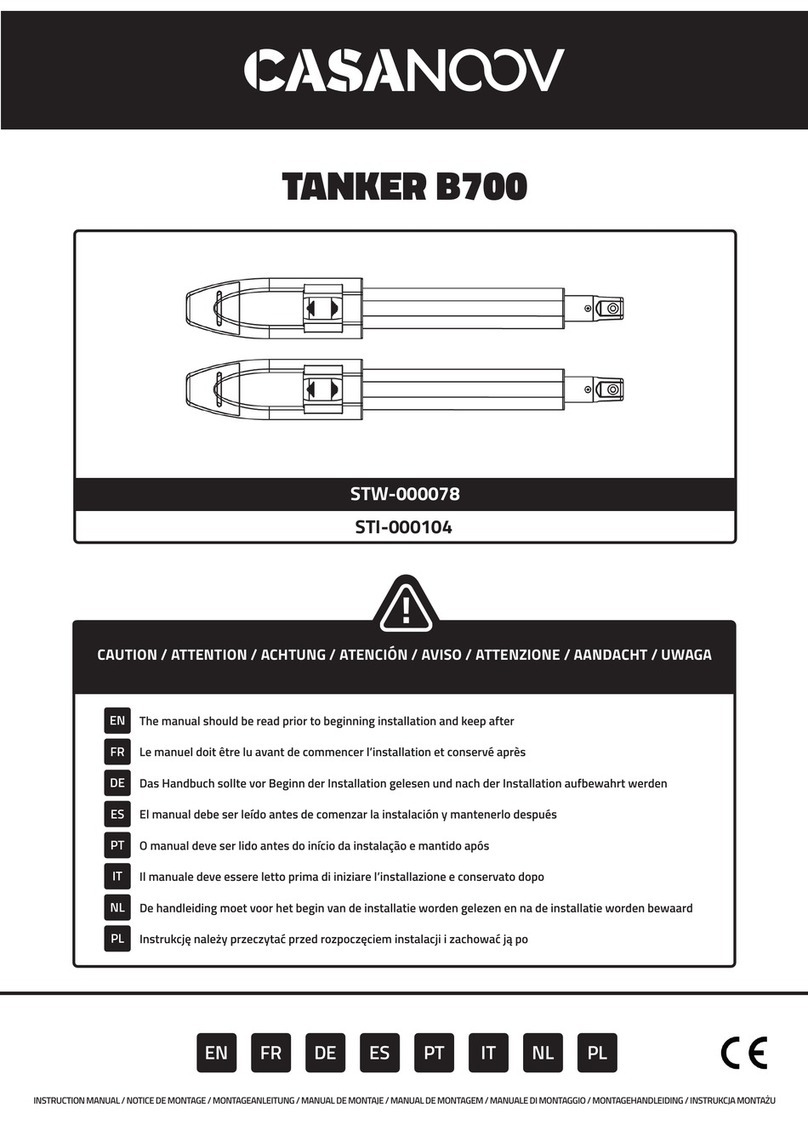
Casanoov
Casanoov TANKER B700 manual
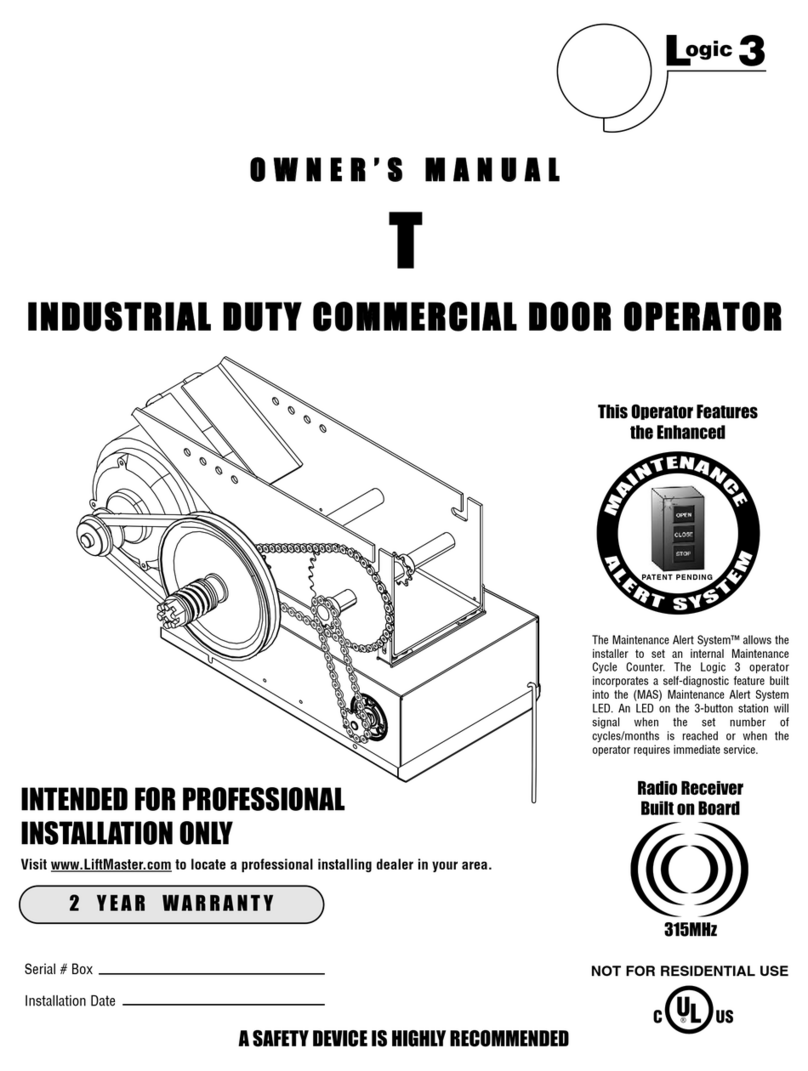
Logic3
Logic3 T owner's manual
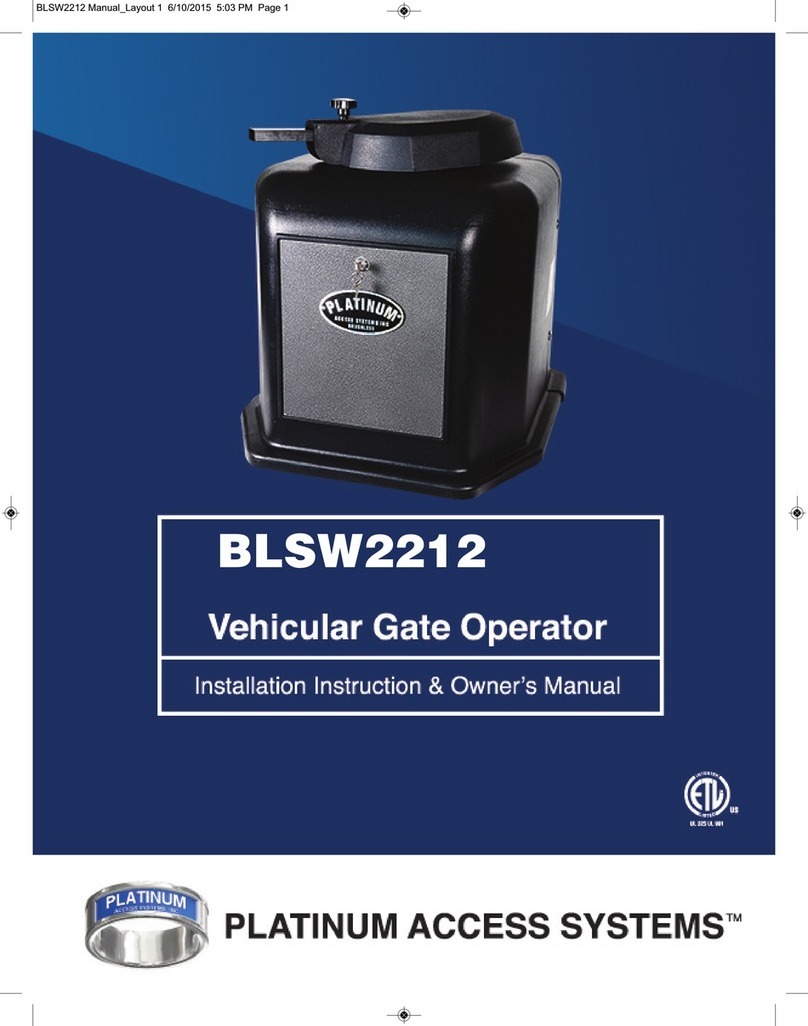
Platinum Access Systems
Platinum Access Systems BLSW2212-B Installation instructions & owner's manual

Mirrow
Mirrow Moovo LN4 Series Installation and use instructions and warnings
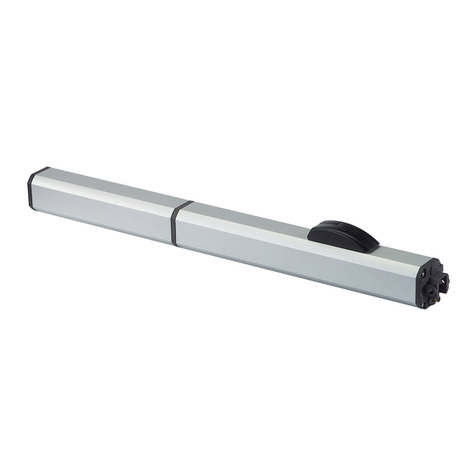
FAAC
FAAC 400 instruction manual
